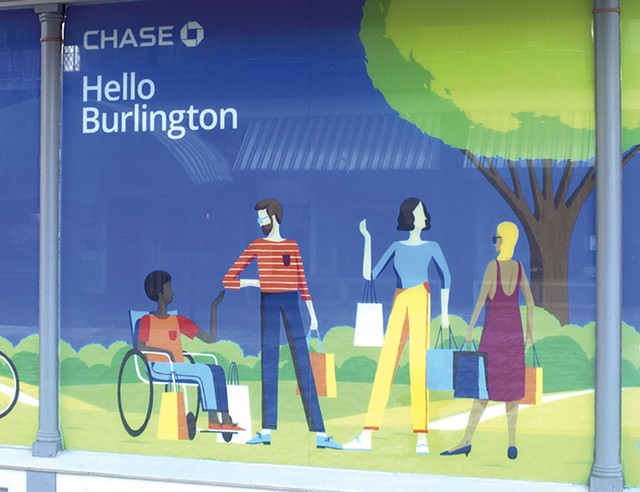
'Damn Good Journalism'
Chelsea Edgar is an absolutely amazing writer. Reading her ["Mother Load," March 10], I felt this crazy swirl of things: guilty relief that my pandemic life has been relatively stable; anger about how — even in Vermont — we haven't figured out how to make life not suck for everyone; a rush of empathy and affection for these three brave, strong, nearly broken women. Her writing made it all the way into my heart. That's a mark of damn good journalism. Thank you.
Jason Van Driesche
Burlington
Another Mother
Chelsea Edgar's article was outstanding and heartbreaking ["Mother Load," March 10]. All during the months last year, I felt so fortunate to be 59 years old with young motherhood behind me. That's because I knew how awful it would have been to be a young mother dealing with it.
Holly Wilkins
Lake Elmore
Cruel and Unusual?
As former director of health services for the Department of Corrections, with substantial research and consulting experience in correctional health care at a national level, I was compelled to respond to your article on Gov. Phil Scott's failure to provide the COVID-19 vaccine to inmates in the care and custody of the Vermont DOC ["'Cesspool of COVID-19,'" March 10]. A deeper dive into the constitutional requirements regarding health care services for inmates, as well as national trends on the subject of inmates' access to the vaccine, would have revealed the following.
Under the Eighth Amendment, correctional jurisdictions must protect inmates from cruel and unusual punishment; this means that inmates must be provided with access to timely and appropriate medical interventions to assess, diagnose, treat and prevent health conditions. Scott's decision to deny inmates access to the vaccine, despite his knowledge that inmates are at increased risk of contracting the virus, amounts to deliberate indifference to inmates' medical needs — a clear constitutional violation.
Oregon's courts have addressed the matter. Failure to provide inmates with timely access to the vaccine is a violation of the Eighth Amendment, and inmates must be provided with the vaccine immediately.
Scott should question whatever consult he has received on the matter related to inmates' access to the vaccine — clearly the DOC is not up to speed on the most basic principles of correctional health care, which should concern us all. Advocacy organizations should file an emergency injunction for the vaccine to be made immediately available to all Vermont inmates, in and out of state.
Ben Watts
Georgia
The Trouble With Murals
Margaret Grayson's article "Art Out of Time" [March 10] reminds me of when my husband and I toured the state capitol in Jefferson City, Mo. The state hired Thomas Hart Benton to paint murals on the four walls of a legislative chamber in 1933. Benton did so. They hated it. It glorified Missouri folklore and the folks who tell it, and it depicted the rich and their political allies in an unflattering way. But they could not afford to get it repainted because they knew, if they did, there would be public outcry over wasted taxpayer funds. So, they used it to snuff their cigars, spat tobacco juice on it and in other ways tried to make sure future generations would do away with it. Instead, it was restored.
Those campaigning to remove or hide Sam Kerson's mural complain that the African Americans in his mural are "caricatures designed to perpetuate the white superiority views." But notice the absence of white superiority in the caricatures of the white people in it. The slave drivers are green (for love of money?) and look ridiculous. The orange-faced abolitionists are also lacking "white superiority" or any sign of pride.
What I see are proud Africans who have captured a green white man and are celebrating (as in Amistad); a slave driver with a whip facing defiant brown men (as in "Roots"); and the slave hunter's path blocked by a blond woman protecting runaways hiding nearby (as in Harriet Tubman stories). And the orange-faced abolitionist is signing a document that causes a brown man to express his amazement that it is really happening: He's going to be free!
I wonder, if the artist were a Black man, would anyone complain about his mural?
Lori Wilson
Hinesburg
Possible Possum
Your March 3 article about museums ["Framing the Questions"] mentioned how the Fleming Museum of Art removed a painting of an elderly brown gentleman cooking possum because the dialect was supposedly racist. Actually, the situation and the dialect were accurate for the times and a "tribute" to the chef. In addition to living in Vermont, I have spent substantial time in the states of Pennsylvania, North Carolina, Virginia and Connecticut, which has given me some cross-cultural background. Perhaps the folks at the Fleming are undereducated or basing decisions on current emotion rather than fact. I hope not.
Warren Ross
Coventry
'Just Cause' and Effect
[Re Off Message: "Burlington Voters Back Ballot Measures on Weed, Evictions by Big Margins," March 2; "A Just Cause? Landlords, Tenants Battle Over Burlington Eviction Proposal," February 15]: The wrongly titled "Just Cause Evictions" charter change that Burlington voters recently approved is misleading and offers no protections from the high costs and lack of housing. The premise is that renters can be evicted at any time for no cause, which simply is not true. Currently leases are for a set period, typically 12 months, during which time tenants cannot be evicted without cause. "Just cause" will do away with lease end dates in Burlington. Renters could decide to stay for years and years and years, and property owners would have no say in the matter.
We all agree that it's time-consuming and expensive to turn over apartments, but sometimes not renewing a lease helps remove a tenant who's delinquent on rent or harassing of or not compatible with other tenants. Otherwise, landlords and other renters will be stuck with a bad neighbor or the very time-consuming and expensive eviction process. Expect a much more thorough application process and rising rents as landlords are forced into never-ending leases.
The majority of local landlords aren't greedy, uncaring out-of-state institutional investors. They are hardworking mom-and-pop property owners, former tenants, and caring members of our community who have saved up and invested in Burlington.
If this charter change is approved at the state level, it will not just be property owners getting "stuck" with difficult tenants — it will also be most of the tenants in our community that this ordinance fails to protect in an already tight rental market.
Steve Lipkin
Burlington
Lipkin is a Burlington Realtor.
Airport Garage Needs Help
In a recent Pomerleau Real Estate ad ["Boarding Call for BTV: Burlington's Airport Is Ready for Takeoff," February 24], I was disappointed not to read anything about a rehab of the Burlington International Airport garage during this period of vastly reduced use. Gene Richards likes to tell us what an outstanding job he and his team are doing, and rightfully so in many respects, but with the finances and bond rating in good shape, why hasn't any attention been given to this problem? It seems like an opportunity that truly creative management would not have missed.
Steven Wood
Essex Junction
Count Canaan
Many thanks for your great article on our neat little club [Staytripper: "Roads Less Traveled," February 24]. You covered a lot of ground and really gave the essence of what the 251 Club is all about.
I do have one slight correction to offer. You had mentioned Beecher Falls being a town. Actually, Beecher Falls is a village or hamlet in the town of Canaan, the northeastern-most town in the state. Sorry to be nitpicky, but I am a bit of a detail freak.
I just finished my 251 this past Veterans Day up in Lewis. It was a quest I started 52 years ago as a 16-year-old. It has been an awesome adventure, and about 100 towns were visited while going to the old-time fiddle contests we used to have back in the '60s, '70s and '80s. In addition to the 251 towns, there are also three gores — Buels, Warren and Avery's — as well as one other interesting tract called Warner's Grant. For some reason, the club does not require you to visit these four places to be a club completer.
Bill Guenther
Newfane
Raising a Flag
[Re Off Message: "Bill Would Bar Black Lives Matter and Other Flags From Flying at Schools," February 2]: Since 1972, public buildings including schools have been flying the Prisoner of War flag. Why, all of a sudden, is a group of Vermont legislators wanting to ban Black Lives Matters flags? Indeed, the issue of mistreatment of Americans of color goes back to 1619. Think of that: more than 350 years prior to the Vietnam War. So what is the agenda of the eight Republicans in the Vermont House of Representatives?
The POW flag was initiated by a group of POW families. The BLM flag was initiated by a group of Black citizens whose families have been prisoners right here on American soil for centuries, right up until today.
I'd like to think that there is a consensus of understanding historically that the treatment of Black people in this country has been and remains unacceptable. Not so with regard to the war in Vietnam, which remains to this day an issue of controversy. But the Republicans are calling the BLM movement a political agenda. Since when is the mistreatment of humans a "political agenda"?
I entreat those eight Republicans to give this some serious thought and rescind their House bill H.92.
Russ Layne
Danby
Graffiti Not for Sale
[Re "Tag Team," February 17]: In Sally Pollak's article on graffiti in Burlington, I was struck by some dissonance between possible motivations of the artists featured and the goals of Arts So Wonderful to shift them in a different direction — to production of art for sale in a gallery. I'm curious if folks who are "totally fucking fed up with a system that doesn't pay any attention to them" and who paint work that says "fuck capitalism" would be satisfied by a commercial outlet selling traditional canvas paintings.
This question is not intended as a critique of Arts So Wonderful or any other specific organization, but of the assumption that admittance into the capitalist art market of canvas paintings intended to adorn the walls of those who can afford them is a suitable transition for a type of art that has a very different "aboutness" about it.
It seems to me that graffiti is imbued with an implicit frustration with capitalism and private property ownership and aims to make work that is visible to all community members, regardless of the aesthetic preferences of business owners or property managers. I'm curious how much of that can be translated into work that is intended for sale.
Kristian Brevik
Burlington
Save Our Schools
[Re "Cliff Notes on Rural Education," February 17]: What young family will choose to make their home in a Vermont town without an elementary school? How much property tax can closing an elementary school cut? Administrative, food service, health care and maintenance staff may be laid off, but school buses and drivers must be funded instead. If teacher-student ratios are preserved, teachers and teachers' aides cannot be laid off.
I served on a school board in Québec, where the provincial income tax funded per-student operating-expense grants and justified capital-expense grants. We also could fund via local property tax up to 5 percent of our annual budget for schools' discretionary expenses. We still closed elementary schools when enrollments became too few.
What if Vermonters innovated a solution? What if the solution must preserve local elementary schools? The internet can interactively connect local elementary schools staffed by teachers' aides. Classroom teachers can make their weekly rounds of these schools, teaching in-person at one and to the rest of them interactively that day. Art, music and physical education teachers can make their weekly rounds as now.
These and similar grassroots suggestions, not consolidations and closures dictated from Montpelier, will find our "Vermont way."
Howard Fairman
Putney
Wood Wiser
[Re "Carbon Quandary," October 9, 2019]: We are facing climate choices that will determine the future of living on Earth. Wood burning creates particulate pollution that damages human health while speeding global climate change.
Wood is not an instantly renewable fuel source. It takes 50 to 75 years for a newly planted tree to grow to its full carbon-absorbing potential. Our carbon dioxide emissions need to go down now, not 50 years from now.
Vermont has no old-growth virgin forests remaining over 10 acres in size. The trees in our woods look like toothpicks as a result of logging. Even loggers can't find many trees large enough for making boards.
Residential wood burning is hypocritical. We don't allow cars and trucks to drive around belching out a cloud of smoke, so why do we permit homes to do so?
State and federal policies that encourage electric cars, heat pumps and solar energy while at the same time promote wood burning are hypocritical and delusional.
Vermont environmental laws put money interests first. All of us should be concerned about the future of the Earth.
Robert Young
West Windsor
Cut to the Chase

- File: Derek Brouwer ©️ Seven Days
- Detail of the window display at Chase bank
There's plenty of color in the window display advertising the impending arrival of Chase bank in Burlington's Masonic Temple building, where the Gap used to be. But at least one city resident — longtime Burlingtonian Jenni Johnson — didn't like how diversity was depicted in the mural-like street scene that wraps around the corner of Church and Pearl streets. The graphic shows people of all stripes engaged in the pre-pandemic activity of social interaction; most of them are carrying shopping bags. But the only Black person in the group is in a wheelchair, with his arm awkwardly extended upward in a gesture Johnson interpreted as begging. Offended, she took her complaint to Chase, the bank agreed to "address it" and Seven Days covered the conflict in a March 10 web story, "After Complaint, Chase Bank to Remove Ad from Church Street." Not surprisingly, some readers took a different view of the odd artwork, which is proving to be something of a racial Rorschach test, and of the bank's speedy resolution of the matter.
Related After Complaint, Chase Bank to Remove Ad From Church Street

Thank you, Seven Days and Courtney Lamdin, for your coverage of the complaint against the Chase bank graphic on Pearl Street. It is important to fairly acknowledge the opinions of Jenni Johnson and Max Tracy and to further acknowledge that these two opinions comprise one strong view of the display — a view that is not shared unanimously in Burlington. It is good that Chase has acknowledged the complaint, and I express hope that some balanced discussion will take place before Chase decides to remove or edit the graphic.
Johnson and Tracy now hold a strong opinion of the display, but calling this "racist and ableist" is only one way to view it. This graphic appears to be a group of seven or more residents during activity on a Burlington sidewalk: some are in conversation, some strolling or biking. I see only a positive in viewing this overall scene, as well as the conversation between a wheelchair user and the person he is speaking to. BIPOC and white residents are equally represented in the graphic if one wishes to do some math.
I would urge some healthy discourse in Burlington before a hasty condemnation of this community-focused marketing display.
Robert Kiernan
Burlington
I read this article, and my immediate reaction was to feel badly that it caused such negative feelings in Jenni Johnson. Everyone reacts differently to things.
Then I looked more closely at the Chase ad to try to understand better. What I saw were two male friends — one Black, one white — exchanging some kind of nonverbal communication. Why do I think they were friends? They had the same shopping bags, so they probably were out on Church Street together. The guy in the wheelchair couldn't possibly be panhandling, since he had the money to fill the two fancy shopping bags.
The more I thought about it, it seemed that Chase had gone out of its way to remove the likelihood of hurting anyone's feelings. They could have easily stuck a token Black guy in the background of the picture, but they made him the centerpiece. The fact that he was wheelchair-bound but still apparently living an active, engaged life is a subtle tribute to his strength and self-confidence.
Knowing Chase, they were celebrating how great it is for all people to shop on Church Street — and use Chase's credit cards. But again, people can read the same thing differently, and I respect that.
Robert Bloch
Charlotte
The most prophetic quote in this entire article is, "I don't know what the message is, but it's the wrong message"! When in doubt, cancel it out. Did Jenni Johnson, in her due diligence, bother to communicate with the actual artist, who is the only person truly qualified to comment on what is going on visually? And what if it turns out the artist is a person of color?
This stuff cuts both ways. How racist is it to assume the only reason a Black man in a wheelchair is in the park with his hand out is because he's panhandling? Clearly, the Black man is gesturing with his hand as he speaks to the white man, who is looking down to make eye contact, which is what normal people do when speaking to each other. Rest assured, if Mr. White weren't looking down, he would be racist for ignoring the disabled man and not acknowledging his presence.
Funny how no one brought up the white woman in the background who is using the same hand gesture, simply flipped 180 degrees. Given the evidence so far, they are clearly a mixed-race couple who came to the park that day for no other reason than to beg for money. Is our society at such a loss for clear signs of malice and injustice that we need to make stuff like this up?
Phil St. Aubin
Chicago, IL
Is the Chase mural offensive? I think not. I don't know how anyone could view this artwork as anything other than a creative community mural. It surely depicts what occurs on and near Church Street: a bicyclist, Vermont greenery, a couple walking their baby, two female shoppers conversing, a handicapped shopper conversing with a friend. Isn't it nice that they all exist in harmony no matter their skin color or physical limitations? Kudos to the artist.
I showed this mural to my wife and children, and no one agreed with the objector. The only comment was: "No cow or dog?" It's a shame that some people need to read into things that just don't exist. If the person in the wheelchair were lighter skinned and the person standing were darker skinned, would an issue be raised? The world would be a better place if we did not always assume a racial issue exists when it doesn't.
This article started a discussion at our dinner table. One of my children said that the government and the press always make it a race issue when, in fact, most of the time it is not. Even in this article, does it really make a difference if the objector was white or black? They objected; that is their opinion. We can't please everyone in life; that is just life. The subtle differences make us who we are.
Let's leave the mural and continue to live and work in harmony without reading into things that just don't exist.
John Roberts
Point Pleasant, N.J.
Roberts owns property in Vermont.
'Merchants of Cancer'
Tobacco ads may bring in money, but in carrying that advertising, you are showing hypocrisy and inconsistency. As Allan Brandt documented so well in The Tobacco Century, cigarette companies have had a long history of duplicity. Tobacco, particularly the brand advertised in Seven Days, killed the truth and killed people. As a journal that has high standards of truth and transparency, you cannot afford to sell out to the merchants of cancer.
George Longenecker
Middlesex
Butt Why?
I was shocked to see a cigarette ad on page 41 in the February 17 edition. Please tell me this is not a real ad, but one somehow associated with an anti-smoking campaign.
Michael Mellott
Underhill
Low Point
My wife and I were shocked and very disappointed to see a full-page ad for cigarettes in a paper with a reputation for being socially conscious and progressive. Really? Come on, Seven Days, this was low. Are you that hard up for cash?
Larry Mindell
Williston
Not-So-Lucky Strike
I have now seen two full-page ads in your paper circular advertising Lucky Strike cigarettes with a link to luckystrike.com for coupons. Seriously? I notice that Nevin Zablotsky has also criticized the ad choice in the February 17 issue [Feedback: "What's Next — Ads for Oxy?"]. I would like to add my astonished and dismayed voice to that ad feedback. When I was 10 years old in l959, I started seeing public service announcements and videos about the dangers of nicotine and nicotine addiction. To put these advertisements in your public paper, which is available to a person of any age to pick up, is unconscionable.
The parent company of Lucky Strike is now also selling CBD vapes and may get into THC vapes in the future: The company's chief marketing officer, Kingsley Wheaton, told CNBC recently that CBD is an "exciting growth area for our business for the future." Recently the company launched a CBD vaping product called Vuse in England. Will THC be far behind?
A publisher's note in response to Zablotsky said that you refrain from publishing ads that "include discriminatory language, make fraudulent claims or spread misinformation." Brown & Williamson was purchased by R.J. Reynolds Tobacco in 2004, forming Reynolds American, which still makes Lucky Strike non-filter today. You know cigarettes are bad for you, right? Running these ads is a poor choice of revenue.
Melinde Kantor
Plainfield
Publisher's note: Seven Days is a forum for free speech and a reflection of the diversity of desires and beliefs in our community. We've always been very reluctant to start down the slippery slope of rejecting ads for legal products or services. Despite the well-documented harmful effects of smoking, tobacco products remain legal. There are strict guidelines governing where advertisements for them can appear, and we follow them closely.
We do not accept advertisements that promote hate, violence or illegal products. In ads that are published, we refrain from dictating or censoring the messaging, as long as it doesn't include discriminatory language, make fraudulent claims or spread misinformation.
Seven Days targets an 18-plus audience; the average age of our readers is 41 — old enough to make informed decisions about consuming regulated products such as tobacco, cannabis, beer, wine and spirits. Our parenting publication, Kids VT, does not accept advertisements that encourage consumption of tobacco, cannabis, beer, wine and spirits.
You can find this policy on our website at sevendaysvt.com/advertising-policy.








Comments
Comments are closed.
From 2014-2020, Seven Days allowed readers to comment on all stories posted on our website. While we've appreciated the suggestions and insights, right now Seven Days is prioritizing our core mission — producing high-quality, responsible local journalism — over moderating online debates between readers.
To criticize, correct or praise our reporting, please send us a letter to the editor or send us a tip. We’ll check it out and report the results.
Online comments may return when we have better tech tools for managing them. Thanks for reading.